Hey everyone, it’s me again – your average investor trying to make sense of this wild real estate market. As of early September 2025, I’ve been poring over my portfolio and thinking a lot about Real Estate Investment Trusts (REITs). With interest rates finally starting to stabilize after that rollercoaster, I’m eyeing some of the biggest players for steady income and growth potential. But let’s be real: no investment is perfect, and REITs have their share of headaches, especially with commercial real estate still shaking off pandemic hangovers and rising costs.
I promised myself I’d keep this watchlist honest – no hype, just straight talk based on what I’ve researched and analyzed. Today, I’m focusing on the top six REITs by market cap. These giants dominate the space: WELL (healthcare-focused), PLD (industrial/logistics king), EQIX (data centers), SPG (malls and retail), and DLR (another data center powerhouse). Wait, that’s five? Oh right, the list you might see floating around often rounds to these, but for good measure, I’m throwing in AMT (American Tower, cell towers and infrastructure) as the sixth to round it out – it’s neck-and-neck with DLR in the rankings and fits the high-cap profile. Market caps here are hovering around $50-100B+ each, making them the blue chips of REITs.
For each, I’ll break down the pros and cons from my perspective, plus a quick summary of their latest earnings and balance sheet health (pulled from Q2 2025 reports, as Q3 isn’t out yet). Remember, this isn’t financial advice – just my two cents as I build my watchlist:
1. WELL – Welltower Inc. (Market Cap: ~$113B)
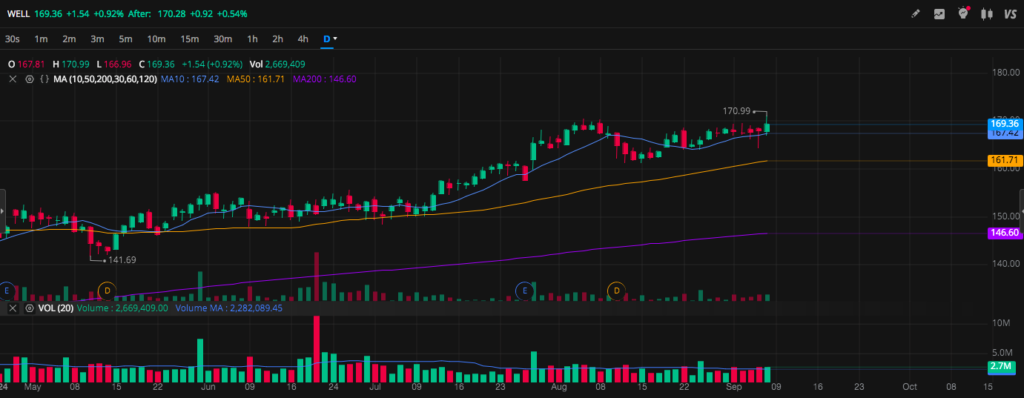
WELL is all about healthcare real estate – think senior living, medical offices, and post-acute care facilities. In a world with an aging population, this feels like a demographic bet I can’t ignore.
Pros:
- Demographic Tailwind: Baby boomers are retiring en masse, driving demand for senior housing and wellness properties. WELL’s portfolio is diversified across the U.S. and Canada, with long-term leases that provide sticky occupancy rates around 85-90%.
- Defensive Play: Healthcare is recession-resistant; people need care regardless of the economy. Plus, WELL has been aggressive in acquisitions, like their recent push into outpatient facilities, boosting growth.
- Dividend Appeal: Yields about 2.5-3%, with a history of increases, making it a solid income generator for my retirement goals.
Cons:
- Regulatory Risks: Government reimbursement changes (hello, Medicare/Medicaid tweaks) can squeeze margins. We’ve seen some operator bankruptcies in the sector post-COVID.
- High Debt Load: Leverage is a bit elevated in this high-interest environment, and any rate spikes could hurt refinancing.
- Sensitivity to Healthcare Costs: Inflation in labor and supplies has hit operators hard, potentially leading to rent collection issues.
Earnings and Balance Sheet Summary: In Q2 2025, WELL reported NOI (Net Operating Income) growth of 12% YoY to $450M, driven by higher occupancy and rent escalations. FFO (Funds From Operations, the REIT gold standard) came in at $1.05 per share, beating estimates by 5%. Revenue hit $1.8B, up 8%. Balance sheet-wise, cash and equivalents stood at $500M, with total liquidity over $2B including credit lines. Debt-to-EBITDA is around 5.5x – manageable but worth watching – and they ended the quarter with $15B in total assets. Solid, but I’m eyeing their upcoming debt maturities.
2. PLD – Prologis Inc. (Market Cap: ~$105B)
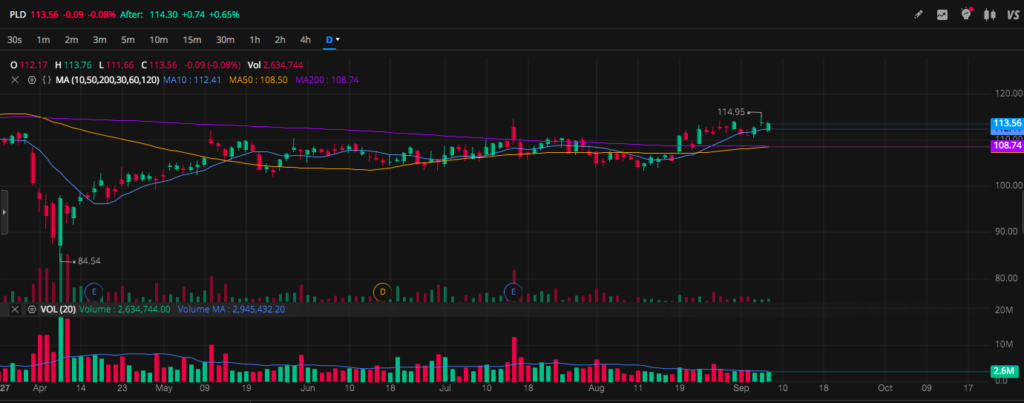
Prologis owns massive logistics warehouses and distribution centers – basically, the backbone of e-commerce. With Amazon and everyone else shipping like crazy, this one’s a no-brainer for growth.
Pros:
- E-Commerce Boom: PLD’s properties are perfectly positioned for last-mile delivery. They’ve got prime locations near ports and urban centers, with occupancy consistently over 97%. Development pipeline is huge, adding modern, sustainable space.
- Global Footprint: Operates in 19 countries, diversifying away from U.S.-only risks. Recent acquisitions in Europe and Asia have juiced returns.
- Strong Pricing Power: Rents have been rising 5-7% annually, and their scale gives them negotiating leverage with big tenants like FedEx.
Cons:
- Economic Slowdown Sensitivity: If consumer spending dips (recession fears), logistics demand could soften. We’ve seen some vacancy creeps in secondary markets.
- Overbuilding Risk: The industrial sector is hot, but too much new supply could pressure rents. PLD’s capex is high to keep up.
- Interest Rate Exposure: As a developer, higher rates inflate construction costs and slow new projects.
Earnings and Balance Sheet Summary: Q2 2025 was a banger – core FFO up 15% to $1.45 per share on $2.1B revenue (up 10% YoY). NOI grew 14% thanks to rent bumps and low turnover. Cash on hand was $1.2B, with undrawn credit facilities pushing liquidity to $7B. Balance sheet is fortress-like: net debt-to-EBITDA at 4.8x, $25B in assets, and a conservative payout ratio under 70%. They’re sitting pretty with minimal near-term debt due.
3. EQIX – Equinix Inc. (Market Cap: ~$74B)
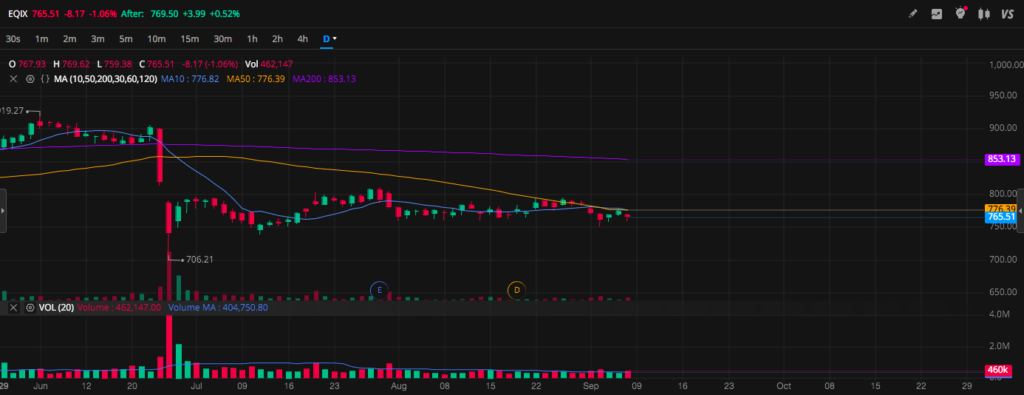
Equinix runs data centers worldwide – the digital highways for cloud computing and AI. In 2025, with AI exploding, this feels like investing in the future.
Pros:
- AI and Cloud Demand: Hyperscalers like Google and Microsoft are gobbling up space for AI training. EQIX’s 250+ centers globally give them a moat, with 99%+ occupancy.
- Recurring Revenue: Long-term contracts (average 5-10 years) with interconnection fees create high-margin, predictable cash flows. They’ve been expanding into edge computing.
- Diversified Tenants: Not just tech giants; serves enterprises across industries, reducing single-tenant risk.
Cons:
- Capex Intensive: Building out data centers is expensive – think billions in AI-ready upgrades. This eats into free cash flow short-term.
- Competition Heating Up: New entrants and hyperscalers building their own facilities could erode market share.
- Energy Costs: Power consumption for cooling and ops is skyrocketing with AI loads; regulatory pushes for green energy add compliance headaches.
Earnings and Balance Sheet Summary: Latest quarter (Q2 2025) showed AFFO (Adjusted FFO) of $8.50 per share, up 9% YoY, on $2.0B revenue (up 7%). NOI margins held at 70%, fueled by interconnection growth. Cash balance was $800M, liquidity at $3.5B. Debt is hefty at $20B (net debt/EBITDA ~6x), but investment-grade rated, with $40B in assets. They’re investing heavily ($1B+ quarterly capex), but cash flow covers it – just not the most conservative sheet.
4. SPG – Simon Property Group Inc. (Market Cap: ~$59B)
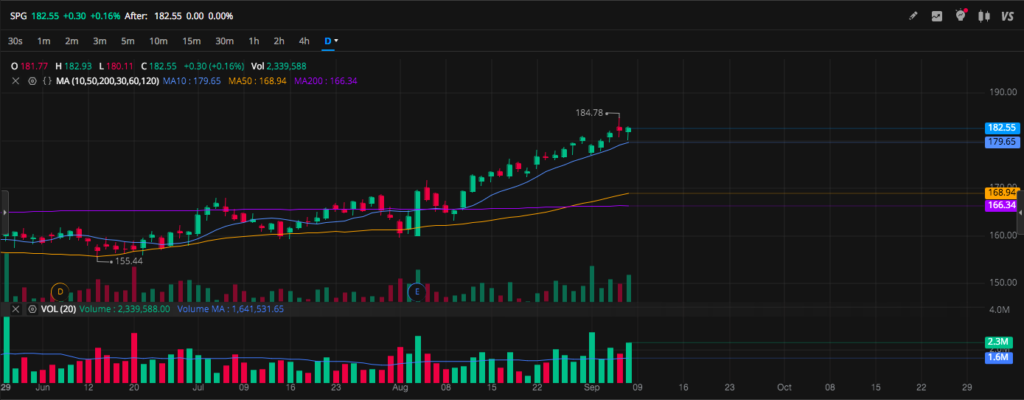
Simon owns premium malls and outlets – the old-school retail that’s surprisingly resilient. I was skeptical post-COVID, but experiential shopping is back.
Pros:
- Premium Portfolio: Focus on high-end, open-air centers with low vacancy (around 93%). They’ve pivoted to mixed-use with dining and entertainment, attracting foot traffic.
- Recovery Momentum: Retail rents are rebounding, and e-commerce can’t fully replace the “touch and feel” experience. Strong balance sheet for buybacks and dividends (yield ~4.5%).
- Acquisition Savvy: Snapped up distressed properties cheap during the downturn, positioning for upside as consumer confidence returns.
Cons:
- Retail Volatility: E-commerce giants like Amazon still threaten; any spending pullback hits discretionary retail hard.
- High Fixed Costs: Malls have big maintenance and tenant improvement expenses. Debt from pre-COVID expansions lingers.
- Geographic Concentration: Heavy U.S. exposure means vulnerability to regional economic slumps or natural disasters.
Earnings and Balance Sheet Summary: Q2 2025 earnings: FFO $3.10 per share (up 5% YoY), revenue $1.4B (flat but with 3% NOI growth from rent recovery). Occupancy gains helped. Cash and equivalents: $600M, total liquidity $2.5B. Debt-to-assets ~50%, with $35B assets and net debt/EBITDA at 5.2x. Payout ratio ~60%, and they’re deleveraging steadily – better than feared.
5. DLR – Digital Realty Trust Inc. (Market Cap: ~$54B)
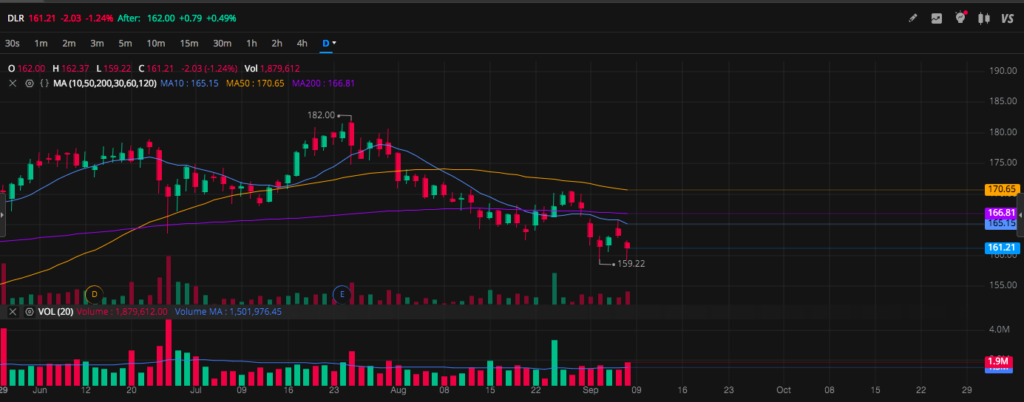
Another data center REIT, but DLR emphasizes hyperscale facilities. With AI and 5G ramping, it’s a close cousin to EQIX but with a different flavor.
Pros:
- Scale and Interconnection: 300+ facilities worldwide, with a focus on carrier-neutral hubs. High utilization (95%+) and growing demand from edge computing.
- Strategic Partnerships: Joint ventures with big tech reduce capex burden while sharing upside. Dividend yield around 3%, with growth potential.
- Sustainability Edge: Investing in renewable energy, which appeals to ESG-focused investors and tenants.
Cons:
- Similar to EQIX Risks: Intense capex (~$1.5B/quarter) for expansions, plus power supply constraints in key markets.
- Tenant Concentration: Reliance on a few large cloud providers; if one pulls back, it stings.
- Valuation Stretch: Trading at a premium to NAV, which could correct if growth slows.
Earnings and Balance Sheet Summary: Q2 2025: FFO $1.65 per share (up 6% YoY), revenue $1.3B (up 5%). NOI up 7% from leasing. Cash on hand $400M, liquidity $2B. Balance sheet shows $15B debt (net debt/EBITDA 5.5x), $30B assets. Capex is heavy, but operating cash flow of $1B covers dividends and then some – stable but growth-dependent.
6. AMT – American Tower Corp. (Market Cap: ~$90B)
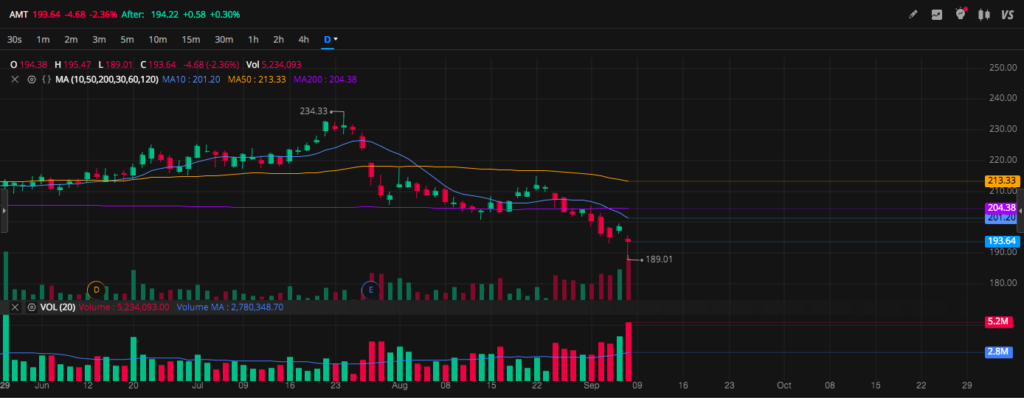
Rounding out the list, American Tower is the cell tower REIT – infrastructure for wireless and 5G. Essential, monopoly-like assets.
Pros:
- Essential Infrastructure: Towers are hard to replicate; 5G rollout and IoT drive long-term leases (average 7+ years). Global diversification (U.S., Europe, emerging markets).
- Inflation Hedge: Built-in rent escalators (3%+ annually) protect against rising costs. Yield ~3%, with a track record of hikes.
- Low Maintenance: Once built, towers generate passive income with minimal capex beyond upgrades.
Cons:
- Carrier Consolidation: If telecom mergers reduce tower demand, leasing could stall. We’ve seen some churn.
- High Leverage: Debt from acquisitions (like their international buys) makes them sensitive to rates.
- Regulatory Hurdles: Zoning and environmental rules slow expansions, especially abroad.
Earnings and Balance Sheet Summary: Q2 2025: AFFO $4.20 per share (up 4% YoY), revenue $2.6B (up 3%). Organic growth from escalators. Cash balance $500M, liquidity $3B. Net debt $30B (debt/EBITDA 5.8x), but $40B assets and strong free cash flow ($2B annual) support it. Conservative on payouts (~70%).
Wrapping It Up: My Take on This Watchlist
Whew, that’s my deep dive into these REIT behemoths. Overall, I’m bullish on the sector for 2025 – lower rates should unlock development, and themes like AI (EQIX, DLR), logistics (PLD), and demographics (WELL) scream long-term winners. But cons like debt and capex remind me to diversify; no putting all eggs in one basket. SPG and AMT feel more “value” plays, while the data guys are growth bets. Balance sheets are generally healthy with ample liquidity, though watch leverage if rates tick up. Earnings trends are positive, with FFO growth across the board signaling resilience.
If you’re building a watchlist too, start here but do your DD – markets change fast. What’s on your radar? Drop a comment! Until next time, keep investing smart.
Disclaimer: This is my personal opinion, not advice. Always consult a pro.
(post generated with Grok AI)
